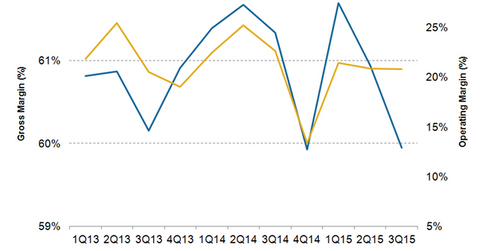Coca-Cola’s 2015 Productivity Initiatives: A Closer Look at Costs
Coca-Cola has been aggressively implementing productivity initiatives to offset the impact of sluggish soda volumes and macro challenges in key markets.
Nov. 20 2020, Updated 3:02 p.m. ET

Productivity goals
At the Morgan Stanley Global Consumer and Retail Conference held on November 17, Coca-Cola’s (KO) chief financial officer (or CFO), Kathy Waller, discussed the company’s productivity efforts. Coca-Cola has been aggressively implementing productivity initiatives to offset the impact of sluggish soda volumes and macro challenges in key markets. The company’s ongoing productivity program aims to generate annualized savings of $3 billion per year by 2019.
Margins in 3Q15
Coca-Cola’s 3Q15 operating margin declined to 20.8% from 22.6% in 3Q14, as the benefits of the ongoing productivity program were offset by structural changes, currency headwinds, and higher marketing investments. The operating margins for PepsiCo (PEP), Dr Pepper Snapple (DPS), Cott Corporation (COT), and Monster Beverage (MSNT) were 8.7%, 20.7%, 3.8%, and 38.5%, respectively, in 3Q15.
Productivity initiatives
The company plans for productivity savings from its cost of goods sold by reducing 15% to 20% of its non-input costs. Coca-Cola’s CFO mentioned the following initiatives in 2015 to reduce the cost of goods sold:
- added in-line blow molding equipment to ten PET bottling lines, which eliminates the requirement to transport bottles to manufacturing plants
- closed or converted seven distribution facilities
- closed four plants
The company expects productivity savings to represent 15% to 20% of its operating expenses. In 2015, Coca-Cola undertook the following initiatives to reduce its operating expenses:
- implemented zero-based budgeting
- reduced headcount by over 1,600, representing ~10% of non-bottling personnel
Coca-Cola is also increasing the productivity of its marketing through reductions in marketing agency costs and other non-media costs. For instance, the company applied procurement best practices in sourcing its marketing materials and services. Marketing productivity savings are expected to represent ~10% of the company’s current direct marketing expense.
Coca-Cola’s CFO stated that the company is striving for margin expansion through a combination of better price realization and productivity initiatives helped by lower commodity costs. The Consumer Staples Select Sector SPDR Fund (XLP) and iShares Dow Jones U.S. ETF (IYY) have 9.5% and 0.8% exposure to Coca-Cola, respectively.
